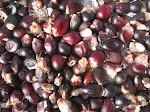
Amaranth and Lambs Quarters
In the past year or two Henry has branched out from harvesting just the wild lamb's quarters, purslane, and amaranth to actually planting some semi-domesticated varieties of these "weeds" grown in parts of the world where they are considered good food, not weeds.
At the market this week, you'll see the wild green amaranth as well as bunches of Golden Giant Amaranth and Hopi Red Dye amaranth. (We use the loose leaves of young Hopi Red - photo above - as part of our mesclun salad mix.)
Hopi Red Dye has magnificently burgundy-colored leaves, and was used by the Hopis to make ceremonial red cornbread. The young plants also make delicious steamed greens, and their leaves can be added to a salad mix, as Henry has done with the mesclun the past few weeks. In addition, many native peoples grind the seeds into a high protein, gluten-free flour. The Golden Giant amaranth is a variant of the Red Dye amaranth.
Magenta Spreen is a variety of chenopodia native to India that has also been cultivated in China and other Asian countries. Like Lamb’s Quarters, Magenta spreen is rich in vitamins A and C, calcium and iron. In the center of the top whorl are beautiful magenta leaves.

Wild Lamb’s Quarters are tasty and nutritious -- read all about them in my column in the June Issue of Mindful Metropolis.
Amaranthus is a “cosmopolitan” genus – found all over the world and valued as a nutritious and delicious food. From Asia to the Himalayas to North and South America, amaranth’s young leaves as well as the mature grain have been a mainstay of widely varying cuisines. It was one of the staple foodstuffs of the Incas, and was also used by the Aztecs and other native peoples of Mexico to prepare ritual drinks and foods. In some Aztec ceremonies, images of gods were made with amaranth mixed with honey, and then cut into pieces to be eaten by the people. This looked a bit too much like the Christian communion to the Spanish priests, who then forbade the cultivation of the grain for centuries.
About 60 species are recognized within the genus Amaranthus, from the Greek amarantos, the “one that does not wither.” As Shakespeare wrote of Cleopatra, “Age cannot wither her, nor custom stale her infinite variety,” so with the gorgeous and nutritious amaranth. Like most native plants, amaranth is a great source of vitamins and minerals, including Vitamins A, B6, C, riboflavin and folate, as well as calcium, iron, magnesium, phosphorus, potassium, zinc, copper and manganese.
Basic Amaranth Greens
3 pounds greens (about 3 bunches)
extra-virgin olive oil
sea salt
lemon wedges or vinegar
1. Rinse greens and coarsely chop greens and stems.
2. Put leaves and stems into boiling salted water for 2 to 5 minutes, or until stems are tender. Drain and squeeze gently.
3. Serve with oil, salt, and lemon wedges.
Amaranth greens can be cooked just as you would spinach, and are excellent in simply boiled or sautéed on their own, or used in quiches, lasagna, or any other way you like spinach. Don’t worry about the big stems, they cook down just as nicely as the leaves, without any stringiness or woodiness.
GREENS SOUP
3 tbsp. butter
2 or 3 green onions
3 tbsp. flour
1 1/2 tsp. salt
Few grains pepper
3 c. milk (or substitute vegetable or chicken broth)
About 2 c. cooked amaranth, lambs quarters, chard, etc -- chopped lightly and cooking liquid
Cook up onions in butter until soft.Add flour and cook until mixture browns. Add salt and pepper. Cook a few minutes over medium heat. Add milk and lambs quarters. Then heat gently. You can either eat as-is, or make it velvety with an immersion blender or food processor.



No comments:
Post a Comment